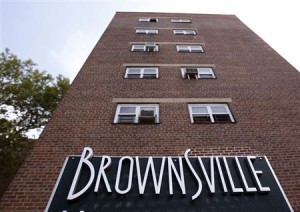HG grew up in a Yiddish-speaking home. There was English, heavily accented English. It wasn’t until HG began elementary school that he learned the proper pronunciation of many words. HG accompanied Mom on bargain seeking forays to busy Bethkit Avenue in the East Bronx. Much later, HG discovered the street was pronounced BATH GATE Avenue (As in the Doctorow book, Billy Bathgate, the basis of the Dustin Hoffman-Bruce Willis film). Similarly, HG thought the far off section of Brooklyn where Mom’s relatives lived was Brunzville. Yes, Brownsville. Little HG enjoyed visits to Brownsville. HG’s cousins showed HG all the local sights: The candy store that was the hangout of Abe “Kid Twist” Reles, “Pittsburgh Phil” Strauss, “Tick Tock” Tannenbaum and other members of the lethal “Murder, Inc.” crew (These bad guys all wore natty wide brimmed fedoras, HG observed); the gym where Al “Bummy” Davis, “Schoolboy” Friedkin, Morrie Reif and all the other Jewish fighters trained; Pitkin Avenue with its movie theaters and Wyona Street with pushcarts and delicatessens. That Jewish enclave, settled by immigrants fleeing the Lower East Side, produced more than killers and prize fighters: Many show business stars (Danny Kaye and Shelley Winters among others); literary lights (Alfred Kazin); doctors, lawyers, Nobel Prize winners. For many years, Brownsville has been an African-American ghetto with few redeeming features. Mike Tyson is probably its most prominent alumnus. Mayor DeBlasio has promised new housing, policing, etc. for Brownsville. HG is hopeful this will mean a better life and future for Brownsville’s citizens. They deserve it.
Brunzville AKA Brownsville
June 1st, 2015 § 2 comments § permalink
The Candy Store
August 20th, 2012 § 1 comment § permalink
New York used to be a city full of candy stores and cigar stores. The classic New York candy store carried regional NYC treats (Little Chunkies, Goldenberg’s Peanut Chews and Joyva Halvah) in addition to the national candy bar brands like Hershey, Nestle, Mars, etc.. It usually had a soda fountain dispensing egg creams, glasses of seltzer (“two cents plain”), milk shakes, “malteds” and simple sandwiches and coffee. It also sold cheap toys and some stationery items (“school supplies”). Cigarettes and cigars, naturally. There was a rack of magazines and comics and outside there was a newsstand. Well into the 50’s New York had four afternoon newspapers (Post, Sun, World-Telegram, Journal-American) and four morning papers (Times, Herald-Tribune, News, Mirror) and for a time, the super-liberal PM (later re-named The Compass). There were loads of foreign language papers: The Forward, Day, Morning Journal, Il Progreso, La Prensa, Aufbau, etc.). There were even two communist newspapers, The Worker (in English) and Freiheit (in Yiddish). After dinner, men strolled to the neighborhood candy store to get the early edition of the News and Mirror. The News was the better, sharper paper but the Mirror had the Walter Winchell column and the latest racing results (a necessity for the inveterate horse player).
The candy store was the hangout of bookmakers, gamblers and money lenders (known as “Shys”). Except in the Times Square neighborhood (where there were no candy stores), New York’s cigar stores didn’t attract quite the same sporting element. Candy stores flourished in Jewish neighborhoods. The tough Brownsville neighborhood of Brooklyn was a predominantly Jewish neighborhood. The lethal Murder, Inc. flourished there. It was typical that the Jewish contract killers (“Kid Twist”, “Pittsurgh Phil”. Albert “Tick Tock” Tennenbaum, etc.) didn’t hangout at bars. Their hangout was a candy store called Midnight Roses’s. When little HG visited his Brownsville cousins they were pointed out as neighborhood celebrities. The Brownsville prize fighters — Al Davis, Morrie Reif, Schoolboy Friedkin, etc. — had their own candy store gathering place.

